An Experimental Study on Torsional Behavior of Reinforced Concrete Columns Retrofitted with Hybrid Concrete Jackets
Abstract
:1. Introduction
2. Experimental Program
2.1. Specimen Details
- (1)
- The strength of the new concrete must be greater than that of the old concrete.
- (2)
- The minimum thickness of the jacket should be 100 mm on each side, and four longitudinal reinforcements should be arranged at least.
- (3)
- The spacing of the stirrup should be less than 200 mm or the thickness of the jacketing section and less than 100 mm in the plastic hinge region of the column.
- (4)
- The dust should be removed as the preparation of the concrete surface before jacketing.
2.2. Test Setup and Loading Protocol
3. Experimental Results
3.1. Cracks and Failure Patterns of Specimens
3.2. Load-Displacement Relationships
3.3. Torsional Moment Versus Twist Response
3.4. Torsional Stiffness
3.5. Energy Dissipation
4. Conclusions
- (1)
- In the case of specimens under unidirectional loading, more significant shear cracks and concrete spalling occurred than that in specimens under bidirectional loading. These results indicated that flexural and torsional moments generated by combined load decreased as the axes of the lateral and axial loads of the bidirectional loading coincided. In the retrofitted specimens using the hybrid concrete jacketing method, fewer cracks occurred than in the non-retrofitted specimens, regardless loading scheme. It is indicated that the hybrid concrete jacketing method can effectively resist torsion and shear.
- (2)
- The maximum load of SFU was about 9.2 times larger than NSU, and that of SFB was 7.4 times larger than NSB. In addition, the hybrid concrete jacketing method increased the cumulative energy dissipation capacity by approximately 7.7 times compared to the old RC columns under unidirectional loading, in which more torsion is induced. Therefore, the hybrid concrete jacketing method can effectively provide torsional resistance without the complex retrofitting process in the existing concrete jacketing method.
- (3)
- For all specimens, the response was linear with increasing applied torsional moment until the initial crack occurred. The torsional moment of SFU was about 4.1 times larger than NSU, and that of SFB was 4.8 times larger than NSB. In the case of NSU and NSB, the increasing rates of the torsional moment from the initial cracking to the maximum torsional moment were 30% and 53%, respectively, and that of SFU and SFB were 68% and 67%, respectively. For torsional stiffness attenuation, the hybrid concrete jacketing method improved the initial torsional stiffness of the RC column subjected to unidirectional load 12 times, and in the case of specimens subjected to unidirectional load, retrofitted specimens were 10 times that of the non-retrofitted column. The torsional stiffness of the non-retrofitted specimens rapidly decreased after the maximum torsional moment was reached due to concrete spalling. This indicated that the hybrid concrete jacketing method could significantly enhance the torsional capacity.
Author Contributions
Funding
Institutional Review Board Statement
Informed Consent Statement
Data Availability Statement
Conflicts of Interest
References
- Tirasit, P.; Kawashima, K. Seismic performance of square reinforced concrete columns under combined cyclic flexural and torsional loadings. J. Earthqu. Eng. 2007, 11, 425–452. [Google Scholar] [CrossRef]
- Prakash, S.; Li, Q.; Belarbi, A. Behavior of circular and square reinforced concrete bridge columns under combined loading including torsion. ACI Struct. J. 2012, 109, 317–328. [Google Scholar]
- Deng, J.; John Ma, Z.; Liu, A.; Cao, S.; Zhang, B. Seismic performance of reinforced concrete bridge columns subjected to combined stresses of compression, bending, shear, and torsion. J. Bridge Eng. 2017, 22, 04017099. [Google Scholar] [CrossRef]
- FEMA 547; Techniques for the Seismic Rehabilitation of Existing Buildings. Federal Emergency Management Agency: Washington, DC, USA, 2006.
- Takiguchi, K. Shear strengthening of reinforced concrete columns using ferrocement jacket. ACI Struct. J. 2001, 98, 696–704. [Google Scholar]
- Hong, S.G.; Lee, J.H.; Choi, Y.; Gu, I.Y. Seismic Strengthening of Concrete Columns by Ultrahigh-Performance Fiber-Reinforced Concrete Jacketing. J. Struct. Eng. 2021, 147, 04021157. [Google Scholar] [CrossRef]
- Guan, D.; Chen, Z.; Liu, J.; Lin, Z.; Guo, Z. Seismic performance of precast concrete columns with prefabricated UHPC jackets in plastic hinge zone. Eng. Struct. 2021, 245, 112776. [Google Scholar] [CrossRef]
- Raza, S.; Khan, M.K.; Menegon, S.J.; Tsang, H.H.; Wilson, J.L. Strengthening and repair of reinforced concrete columns by jacketing: State-of-the-art review. Sustainability 2019, 11, 3208. [Google Scholar] [CrossRef]
- Meda, A.; Mostosi, S.; Rinaldi, Z.; Riva, P. Corroded RC columns repair and strengthening with high performance fiber reinforced concrete jacket. Mater. Struct. 2016, 49, 1967–1978. [Google Scholar] [CrossRef]
- Reggia, A.; Morbi, A.; Plizzari, G.A. Experimental study of a reinforced concrete bridge pier strengthened with HPFRC jacketing. Eng. Struct. 2020, 210, 110355. [Google Scholar] [CrossRef]
- Gholampour, A.; Hassanli, R.; Mills, J.E.; Vincent, T.; Kunieda, M. Experimental investigation of the performance of concrete columns strengthened with fiber reinforced concrete jacket. Constr. Build. Mater. 2019, 194, 51–61. [Google Scholar] [CrossRef]
- Nitesh, K.S.; Rao, S.V.; Kumar, P.R. An experimental investigation on torsional behaviour of recycled aggregate based steel fiber reinforced self compacting concrete. J. Build. Eng. 2019, 22, 242–251. [Google Scholar] [CrossRef]
- Hassan, R.F.; Jaber, M.H.; Al-Salim, N.H.; Hussein, H.H. Experimental research on torsional strength of synthetic/steel fiber-reinforced hollow concrete beam. Eng. Struct. 2020, 220, 110948. [Google Scholar] [CrossRef]
- Okay, F.; Engin, S. Torsional behavior of steel fiber reinforced concrete beams. Constr. Build. Mater. 2012, 28, 269–275. [Google Scholar] [CrossRef]
- Kim, M.S.; Lee, Y.H. Seismic Performance of Reinforced Concrete Columns Retrofitted with Hybrid Concrete Jackets Subjected to Combined Loadings. Materials 2022, 15, 6213. [Google Scholar] [CrossRef] [PubMed]
- Penelis, G.G.; Kappos, A. Earthquake Resistant Concrete Structures; CRC Press: Boca Raton, FL, USA, 2014. [Google Scholar]
- Soufeiani, L.; Raman, S.N.; Jumaat, M.Z.B.; Alengaram, U.J.; Ghadyani, G.; Mendis, P. Influences of the volume fraction and shape of steel fibers on fiber-reinforced concrete subjected to dynamic loading—A review. Eng. Struct. 2016, 124, 405–417. [Google Scholar] [CrossRef]
- Karayannis, C.G. Nonlinear analysis and tests of steel-fiber concrete beams in torsion. Struct. Eng. Mech. 2000, 9, 323–338. [Google Scholar] [CrossRef]
- Song, P.S.; Hwang, S. Mechanical properties of high-strength steel fiber-reinforced concrete. Constr. Build. Mater. 2004, 18, 669–673. [Google Scholar] [CrossRef]
- Fang, C.; Ali, M.; Xie, T.; Visintin, P.; Sheikh, A.H. The influence of steel fibre properties on the shrinkage of ultra-high performance fibre reinforced concrete. Constr. Build. Mater. 2020, 242, 117993. [Google Scholar] [CrossRef]
- ACI Committee 318; Building Code Requirements for Structural Concrete and Commentary. American Concrete Institute: Farmington Hills, MI, USA, 2019.
- ACI 374.1-05; Acceptance Criteria for Moment Frames Based on Structural Testing and Commentary. American Concrete Institute: Farmington Hills, MI, USA, 2005.
- Chen, S.; Peng, W.; Yan, W. Experimental study on steel reinforced concrete columns subjected to combined bending–torsion cyclic loading. Struct. Des. Tall Spec. Build. 2018, 27, e1479. [Google Scholar] [CrossRef]
- He, R.; Sneed, L.H.; Belarbi, A. Torsional Repair of Severely Damaged Column Using Carbon Fiber-Reinforced Polymer. ACI Struct. J. 2014, 111, 705–716. [Google Scholar] [CrossRef]
- Truong, G.T.; Kim, J.C.; Choi, K.K. Seismic performance of reinforced concrete columns retrofitted by various methods. Eng. Struct. 2017, 134, 217–235. [Google Scholar] [CrossRef]
- Paultre, P.; Boucher-Trudeau, M.; Eid, R.; Roy, N. Behavior of circular reinforced-concrete columns confined with carbon fiber–reinforced polymers under cyclic flexure and constant axial load. J. Compos. Constr. 2016, 20, 04015065. [Google Scholar] [CrossRef]
- Shafaei, J.; Hosseini, A.; Marefat, M.S. Seismic retrofit of external RC beam–column joints by joint enlargement using prestressed steel angles. Eng. Struct. 2014, 81, 265–288. [Google Scholar] [CrossRef]
- Chang, S.Y.; Chen, T.W.; Tran, N.C.; Liao, W.I. Seismic retrofitting of RC columns with RC jackets and wing walls with different structural details. Earthq. Eng. Eng. Vib. 2014, 13, 279–292. [Google Scholar] [CrossRef]
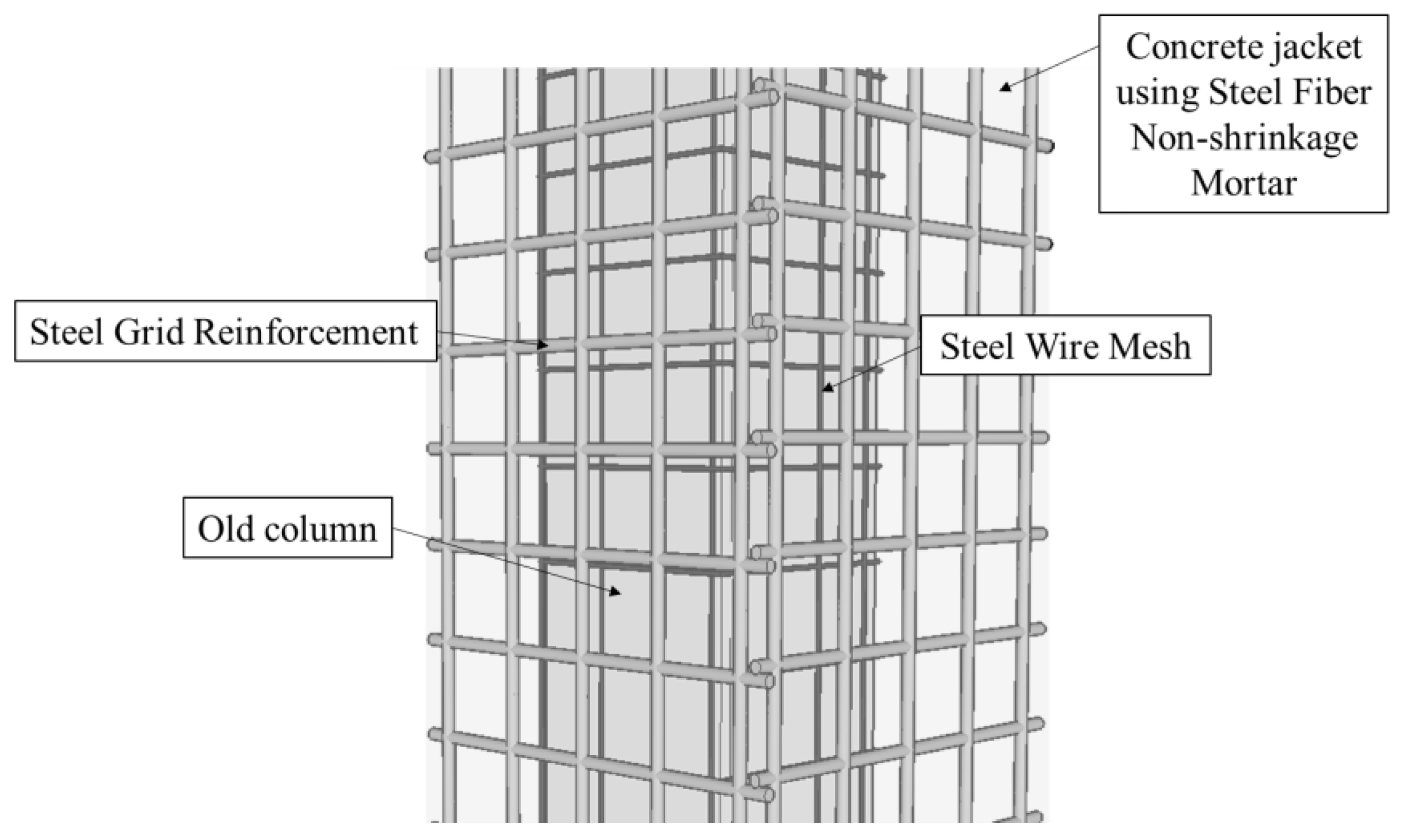
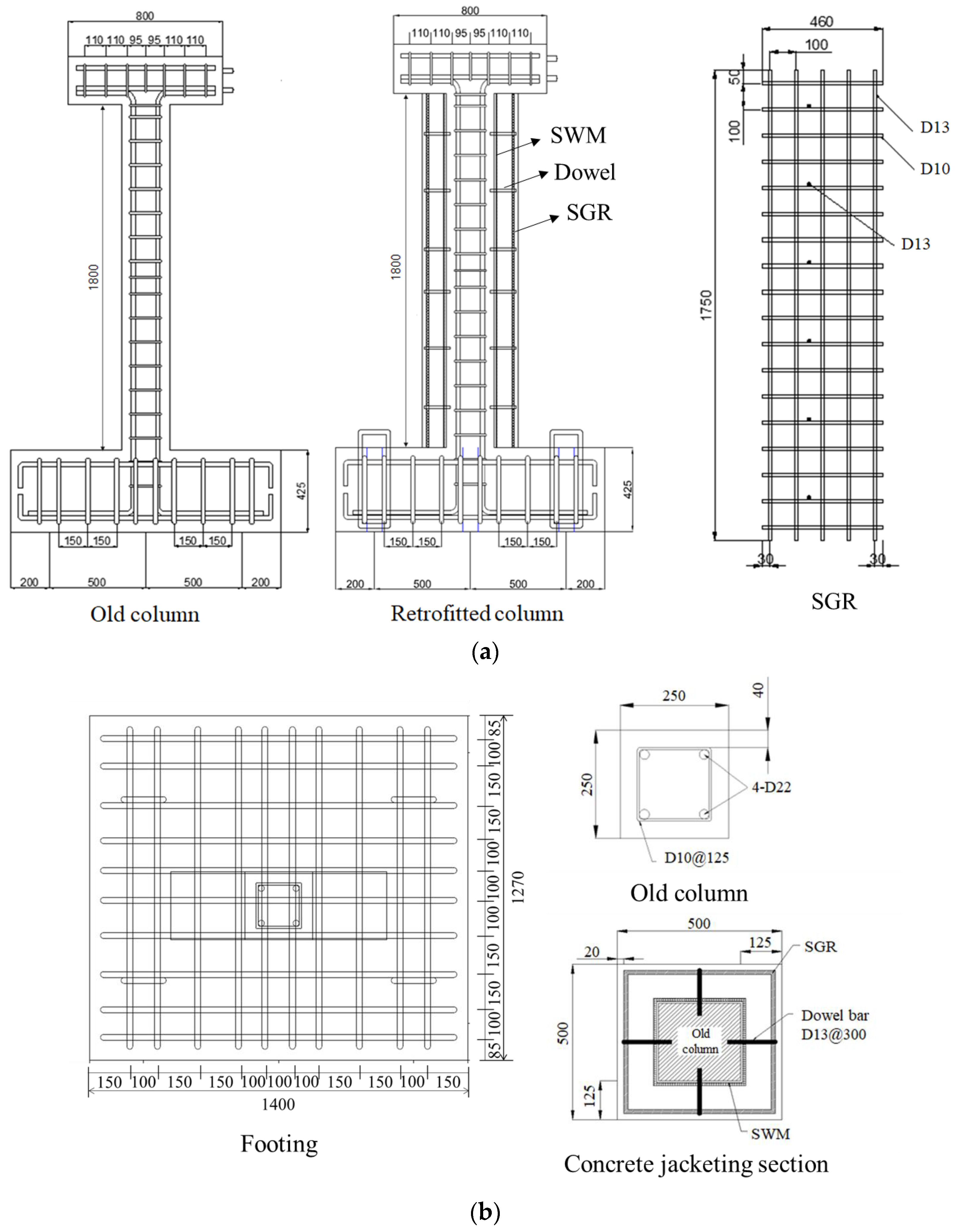

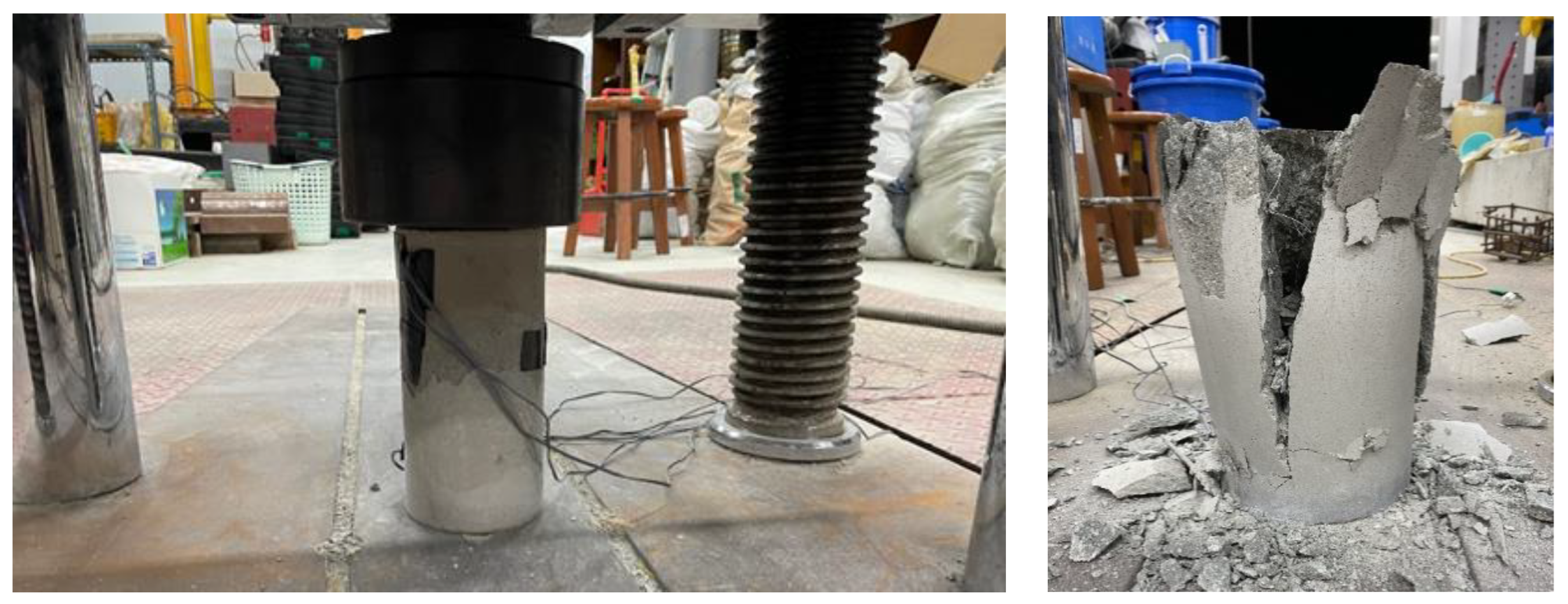

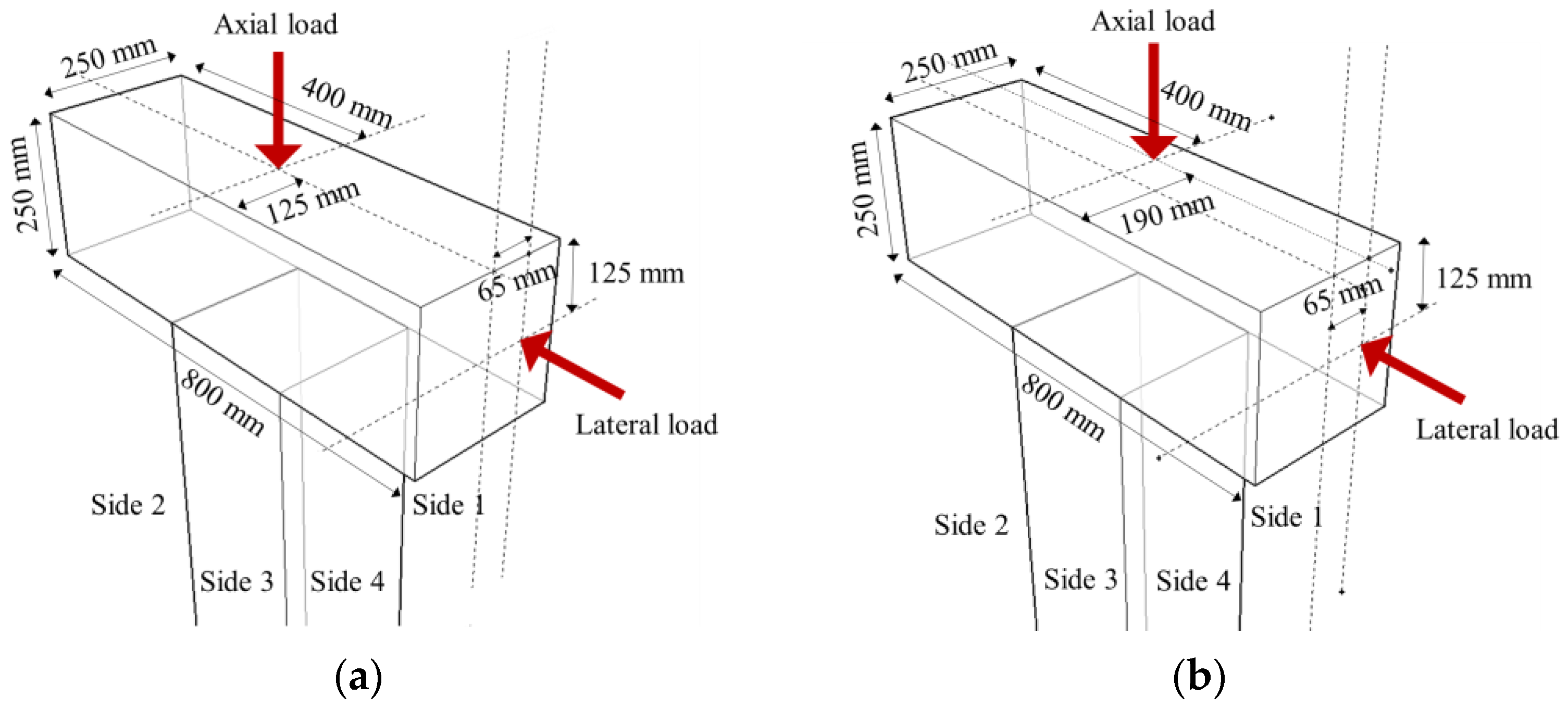
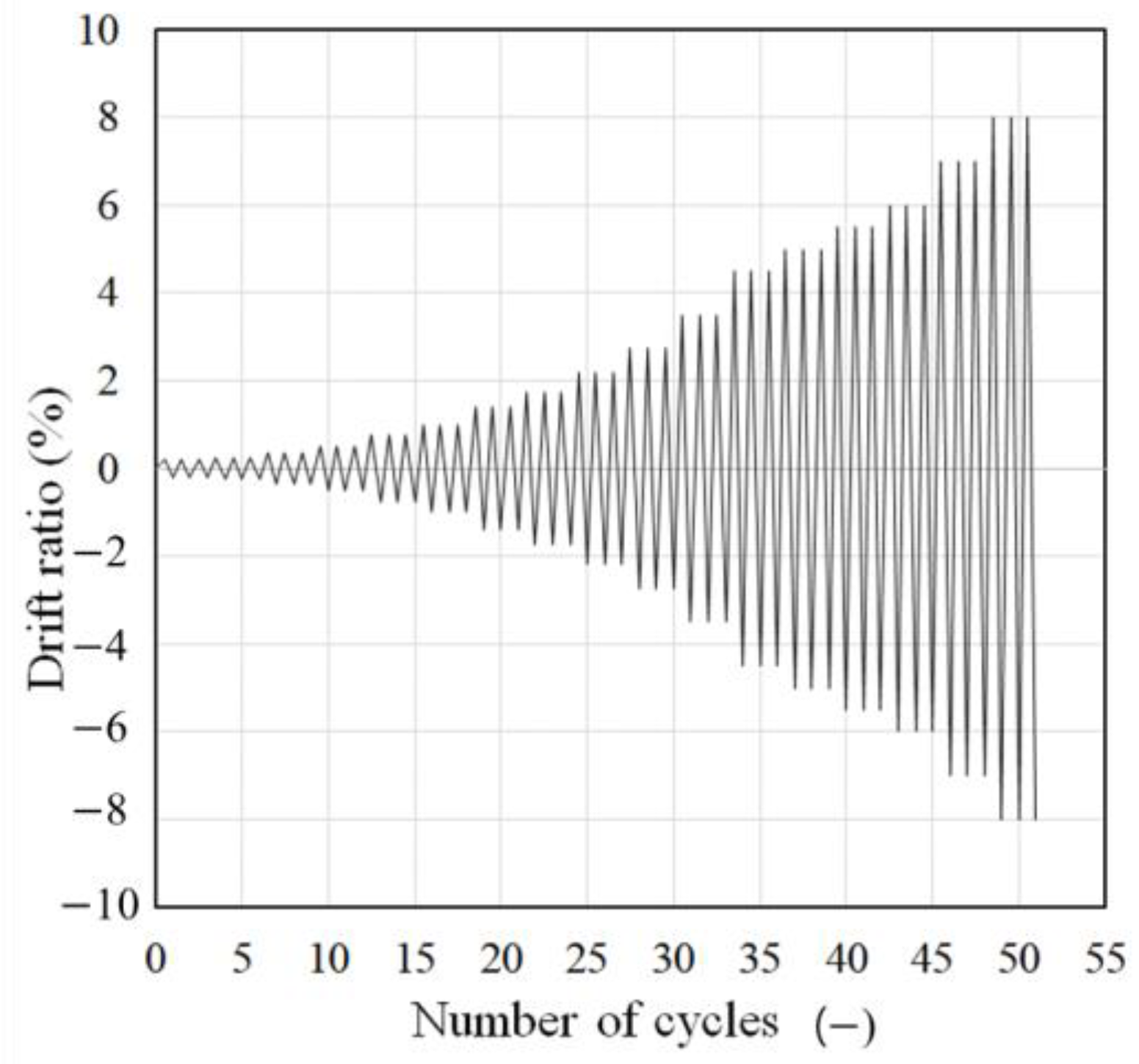
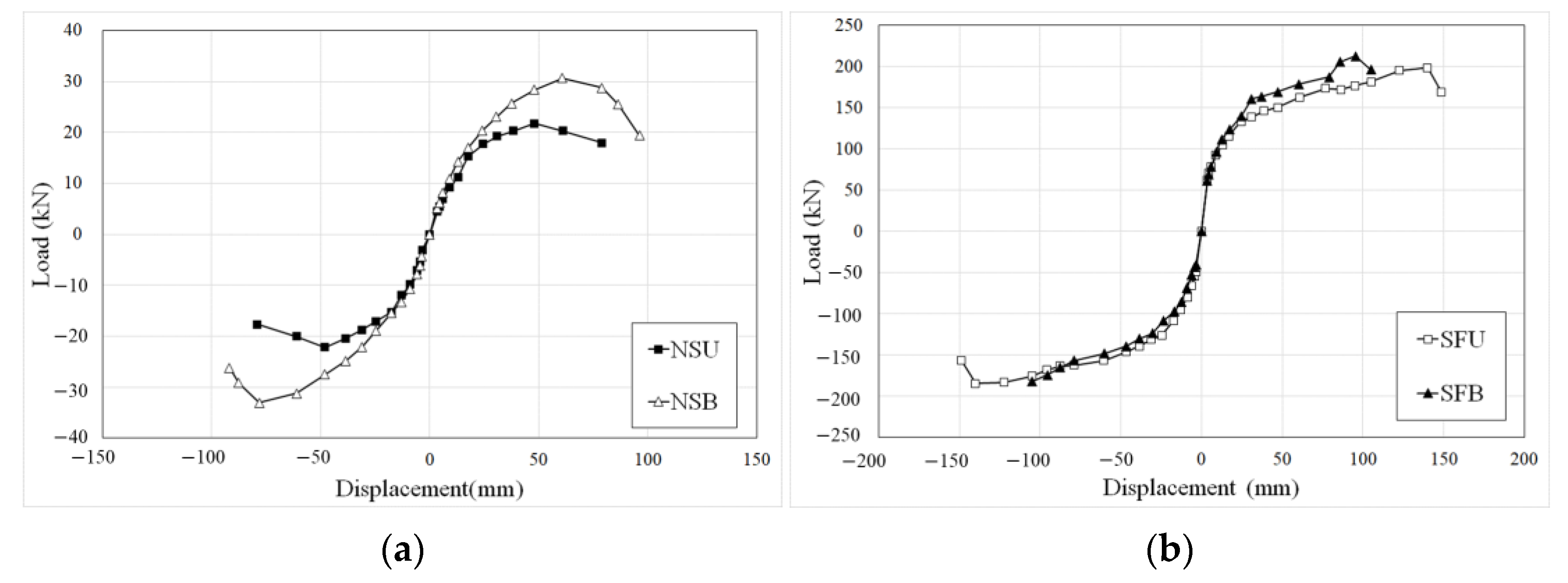
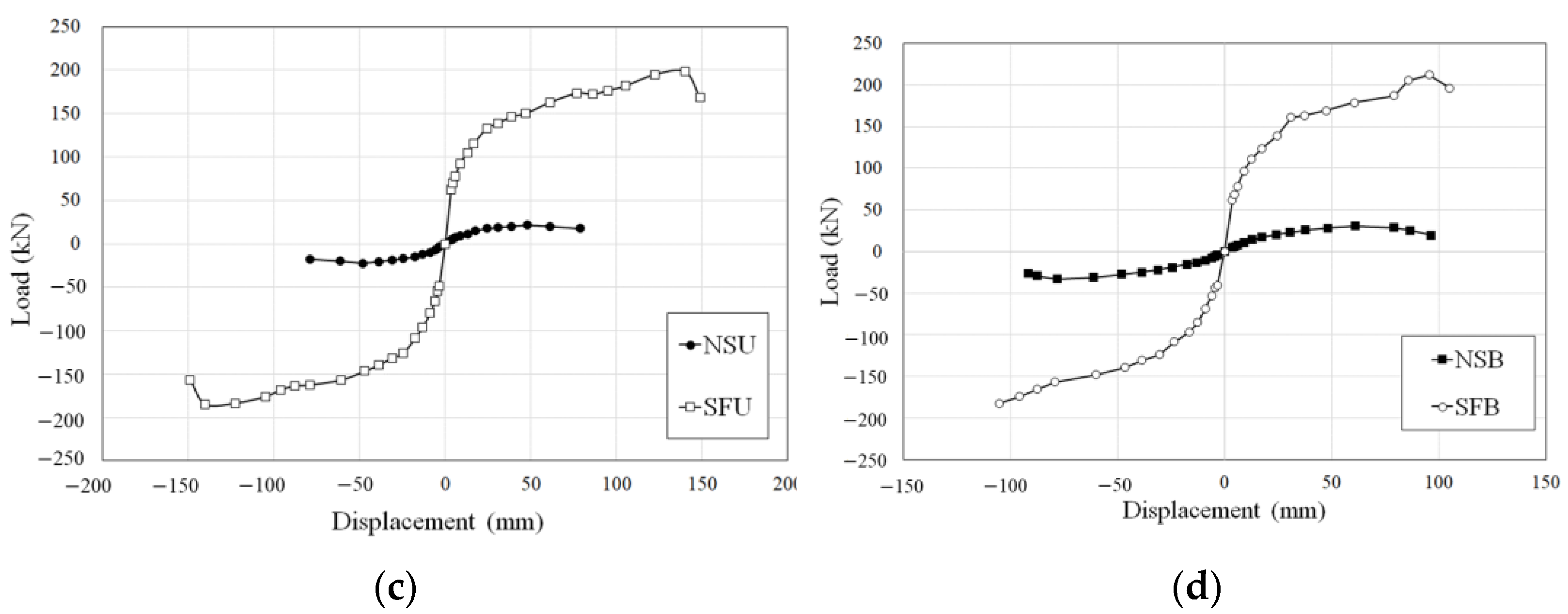
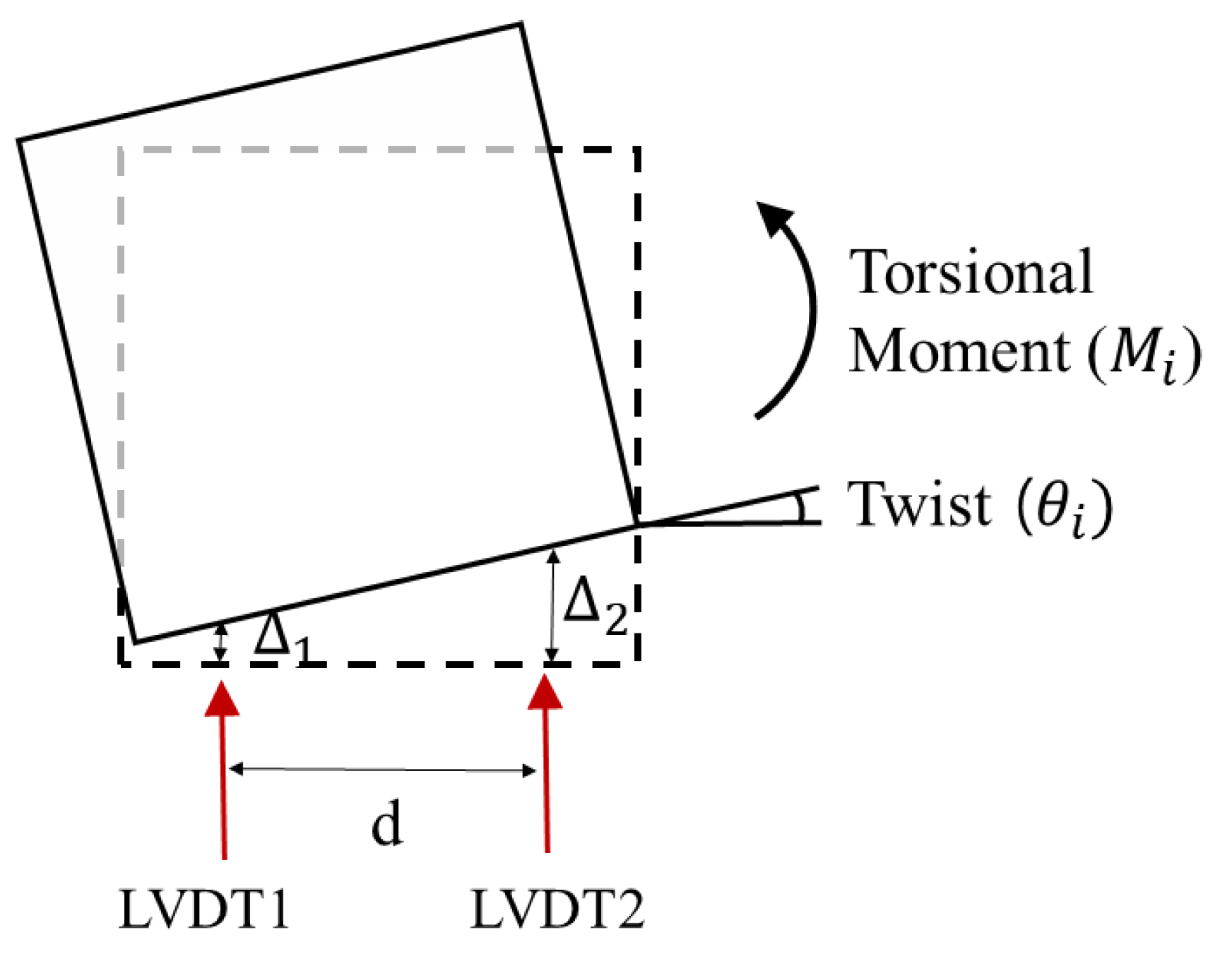
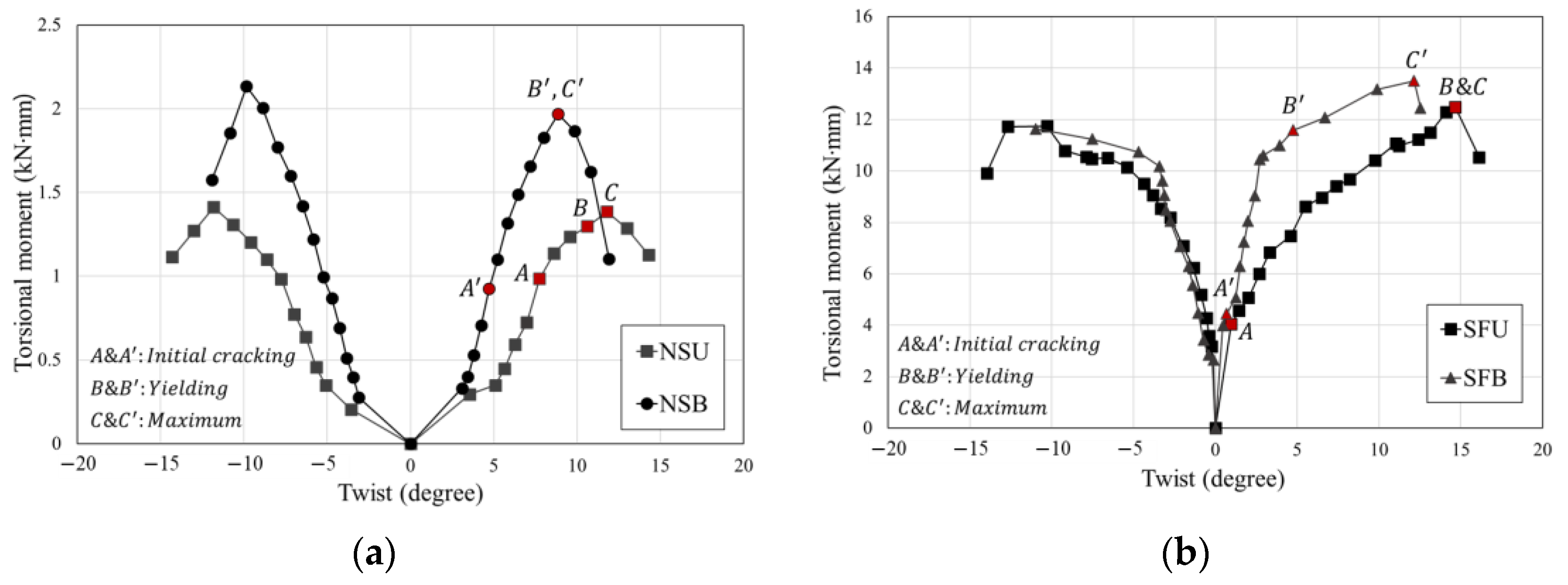

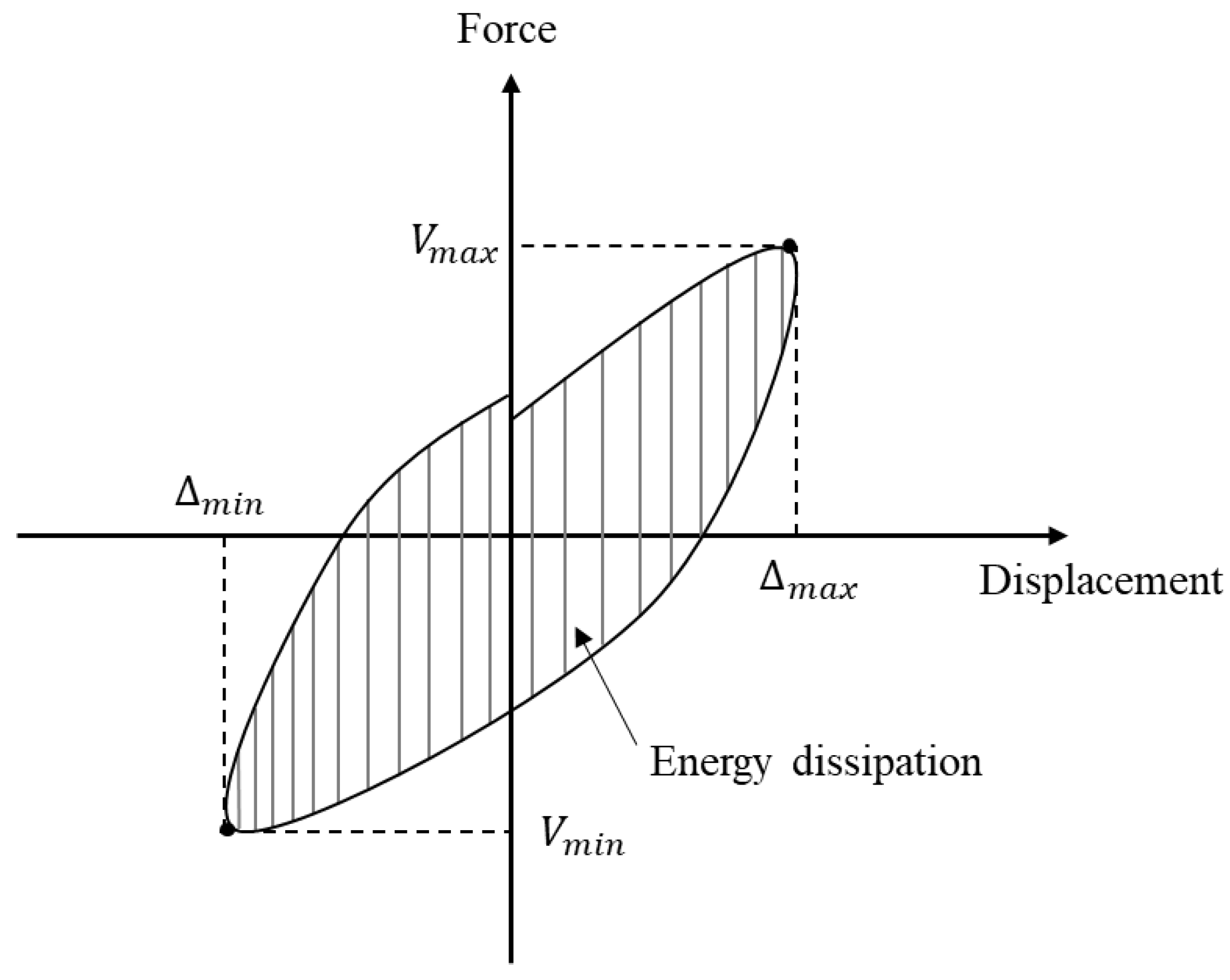
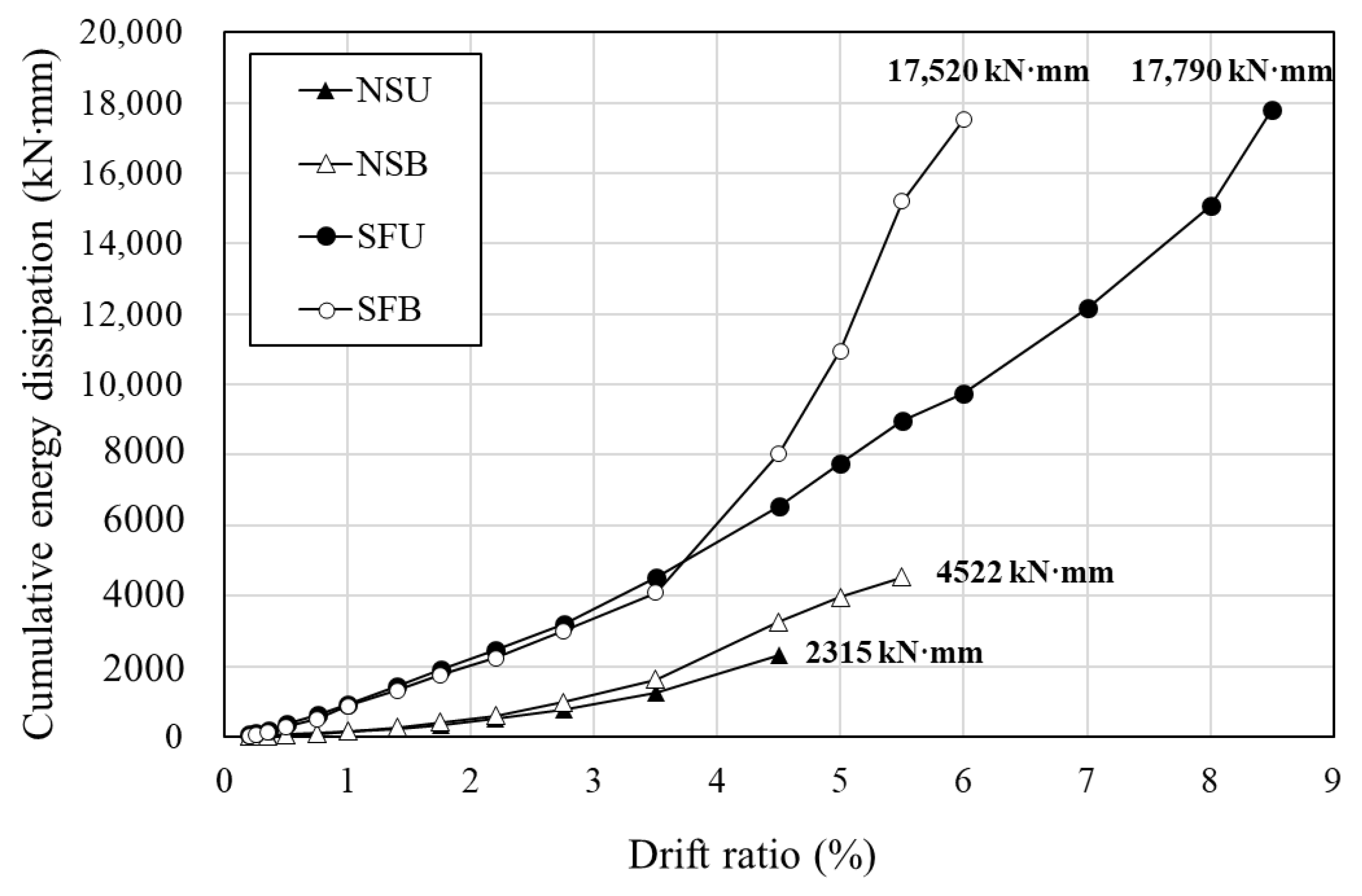
| Specimen | Retrofit Method | Loading Scheme | Cross Section (mm) | Materials | |
|---|---|---|---|---|---|
| Concrete (MPa) | Steel (MPa) | ||||
| NSU | – | Unidirectional | 250 × 250 | 24 | 400 |
| NSB | Bidirectional | ||||
| SFU | Concrete jacketing | Unidirectional | 500 × 500 | ||
| SFB | Bidirectional | ||||
| Material | Diameter (mm) | Length (mm) | Aspect Ratio | Tensile Strength (MPa) |
|---|---|---|---|---|
| Low carbon | 0.34 | 18 | 0.019 | 1250 |
| Specimens | Side 1 | Side 2 | Side 3 | Side 4 |
|---|---|---|---|---|
| NSU |  |  |  |  |
| NSB |  |  |  |  |
| SFU |  |  |  |  |
| SFB |  |  |  |  |
| State | NSB | SFB | ||
|---|---|---|---|---|
| Drift Ratio (%) | Photograph | Drift Ratio (%) | Photograph | |
| Initial shear crack | 1.4 |  | 1.75 |  |
| Concrete spalling | 3.5 |  | 2.75 | 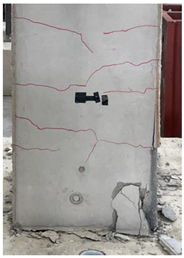 |
| Failure | 5.5 | 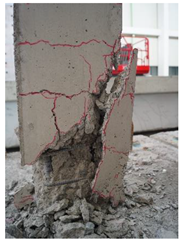 | 6 | 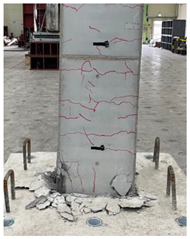 |
| Specimen | Maximum Load (kN) | Maximum Displacement (mm) | ||
|---|---|---|---|---|
| Positive (+) | Negative (−) | Positive (+) | Negative (−) | |
| NSU | 21.61 | −22.26 | 79.08 | −79.03 |
| NSB | 30.66 | −33.32 | 96.35 | −96.38 |
| SFU | 198.32 | −184.75 | 148.76 | −148.75 |
| SFB | 226.22 | −182.29 | 105.06 | −105.03 |
| NSU | NSB | SFU | SFB | ||||||
|---|---|---|---|---|---|---|---|---|---|
| (+) | (−) | (+) | (−) | (+) | (−) | (+) | (−) | ||
| Cracking | (kN·m) | 0.98 | 0.98 | 0.92 | 0.87 | 4.03 | 3.18 | 4.45 | 2.84 |
| (degree) | 7.75 | 7.75 | 4.73 | 4.71 | 0.96 | 0.92 | 0.68 | 0.56 | |
| Yield | (kN·m) | 1.30 | 1.31 | 1.97 | 2.00 | 12.47 | 11.72 | 11.59 | 9.62 |
| (degree) | 10.64 | 10.64 | 8.88 | 8.87 | 14.67 | 12.69 | 4.76 | 3.24 | |
| Maximum | (kN·m) | 1.38 | 1.41 | 1.97 | 2.13 | 12.47 | 11.87 | 13.50 | 11.63 |
| (degree) | 14.30 | 14.30 | 11.92 | 11.92 | 14.66 | 8.75 | 12.16 | 10.97 | |
Disclaimer/Publisher’s Note: The statements, opinions and data contained in all publications are solely those of the individual author(s) and contributor(s) and not of MDPI and/or the editor(s). MDPI and/or the editor(s) disclaim responsibility for any injury to people or property resulting from any ideas, methods, instructions or products referred to in the content. |
© 2023 by the authors. Licensee MDPI, Basel, Switzerland. This article is an open access article distributed under the terms and conditions of the Creative Commons Attribution (CC BY) license (https://creativecommons.org/licenses/by/4.0/).
Share and Cite
Ro, K.M.; Kim, M.S.; Lee, Y.H. An Experimental Study on Torsional Behavior of Reinforced Concrete Columns Retrofitted with Hybrid Concrete Jackets. Materials 2023, 16, 1256. https://doi.org/10.3390/ma16031256
Ro KM, Kim MS, Lee YH. An Experimental Study on Torsional Behavior of Reinforced Concrete Columns Retrofitted with Hybrid Concrete Jackets. Materials. 2023; 16(3):1256. https://doi.org/10.3390/ma16031256
Chicago/Turabian StyleRo, Kyong Min, Min Sook Kim, and Young Hak Lee. 2023. "An Experimental Study on Torsional Behavior of Reinforced Concrete Columns Retrofitted with Hybrid Concrete Jackets" Materials 16, no. 3: 1256. https://doi.org/10.3390/ma16031256





